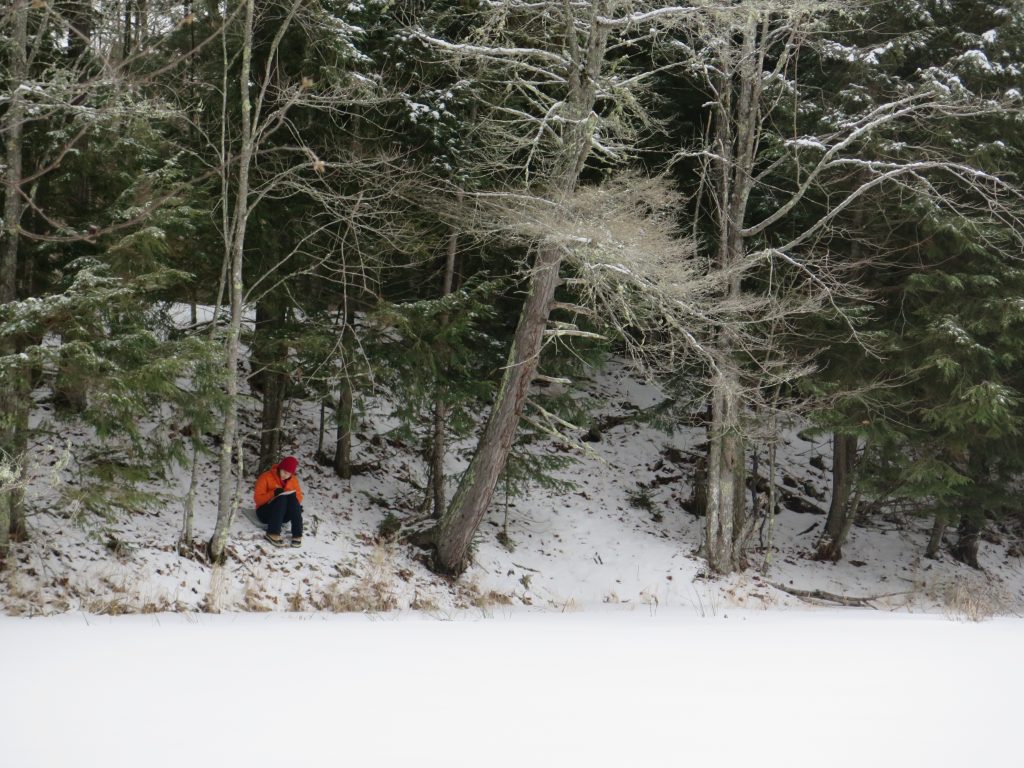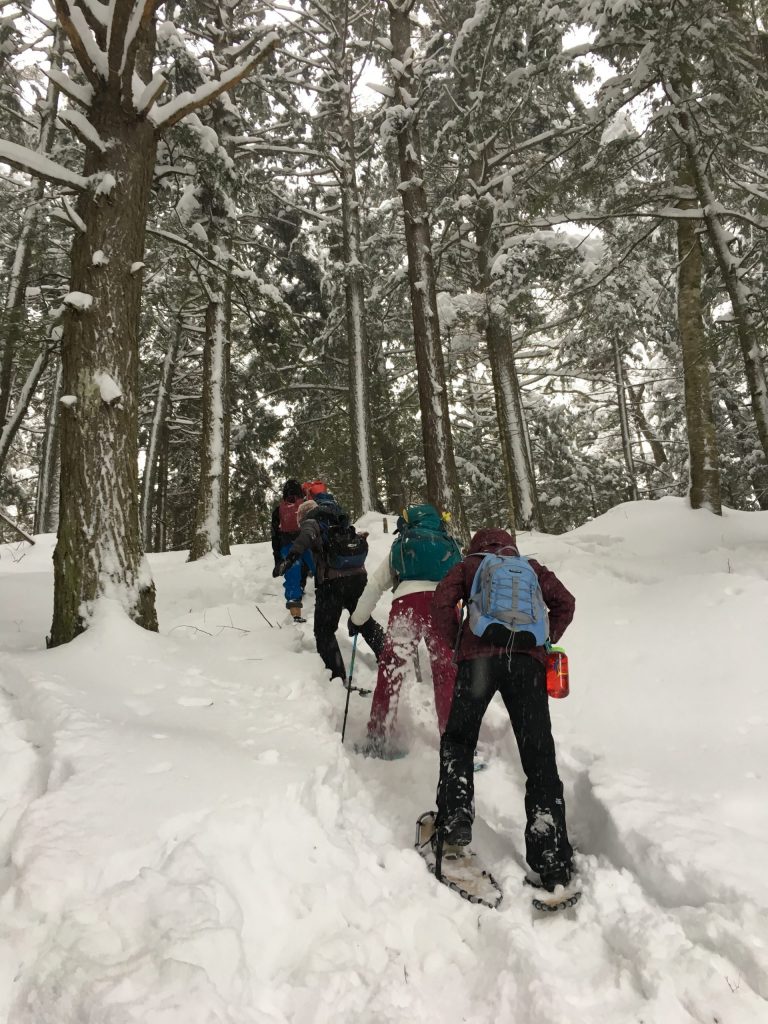By. Eleva Potter
Situated on 12,000 acres of land in northern Wisconsin with access to eight lakes and 20 miles of trail, Conserve School is an idyllic place for young people who are looking to make a deep connection with nature. The private, nonprofit boarding school serves high school sophomores and juniors who attend for four months during a fall or spring semester. Classes at Conserve School are outdoor-oriented and environmentally-focused. Because of the interdisciplinary class structure, different disciplines can combine lessons to focus on fieldwork and how to communicate a connection to nature and advocate for natural places in many different ways.
One example of this can be found in the collaboration between Conserve School’s Earth Art and AP Environmental Science classes. These classes join forces to show students how to make scientific sketches of their observations. Every Wednesday morning, students visit their phenology spots (“sit spots”) for an hour. While they are there, they record the temperature, moon phase, weather, and characteristics of the changing seasons. Students also pose hypotheses about what they are observing in nature and strive to answer their questions with the help of teachers, peers, and field guides. This project encourages students to slow down and really take in a place with all their senses, observe how it changes overtime, and become connected to that special spot.
Science teacher Andrew Deaett explains, “It’s no coincidence that Earth Art and AP Environmental Science share a wing of the LAB (Lowenstine Academic Building). These two disciplines, which may seem disparate, both attempt to bring students to a deeper understanding of our world with a strong emphasis on the practice of observation. As we develop our observational skills, we are training our minds to view the world in an objective manner, refining and trusting our senses. Over the course of the semester, we will continue to infuse art into science, and science into art, cultivating a relationship with our neighbors across the hall.”

Semester 18 student, Dylan, describes his experience, “Visiting my phenology spot throughout the semester has been a truly rewarding experience for me. Every time I go to my spot, sit down, and observe my surroundings, the world seems incredibly alive. I notice little details that wouldn’t normally catch my eye. The act of simply being present in space and time and not worrying about what I need to do next sets a wonderful tone for the rest of my day. Not only do I become more curious and more eager to learn after a visit to my phenology spot, but I also become more thoughtful as a result of my newly found presence and harmony.” Many students show their friends and family their phenology spot over Family Weekend and make time to visit their spot when they return for alumni events because it has become a special place for them where they feel at home and connected to the world around them.
In Conserve School’s combined History and English class, students build on their phenology experience by exploring the neighboring Sylvania Wilderness Area, making observations and writing testimonies about why this place should be preserved for future generations. For this project, students are divided into teams comprised of an artist, writer, photographer, and scientist. Each team is tasked with writing a moving testimony that is read in front of peers, teachers, a former state senator, and members of the Forest Service to convince them to preserve the land for future generations. Called Day of Discovery, this project mirrors the 1871 Hayden Expedition to Yellowstone to document the beauty of the area through writing, photography, and illustration. Through this experience, students go from connecting to a place to advocating for that place’s protection.
Semester 17 student Hadyn describes the experience:
“There were eight students in my group and one adult leader. We started our hike at “Bear 42,” a marker on the edge of Sylvania. Sam and I were chosen to be navigators, took a bearing—313°, or roughly northwest—and all of us embarked on the journey to Mossy Lake. I’m a fast walker. I tend to notice things as I walk, picking out small club mosses and enormous hemlocks with a single glance. I rarely stop to attend to detail. However, as we walked, I had no choice but to slow down and wait for the rest of the group. The photographers wanted to capture everything and the group kept hugging trees to measure how big they were (we found a birch that took three people to encircle!). As the other people were distracted by their respective jobs, I was left alone, in the front of the pack. As a writer, I wanted to wait until I arrived at my destination to start my journaling. So, there I stood—pawing impatiently at the frosted ground. But as I was waiting, I began to notice things I hadn’t seen as I was walking. The thin sheet of ice extending into the bogs, an interesting ball of moss, a cedar and a birch that had intertwined as they grew, and a million other things. Though my legs were idle, my brain was buzzing with activity. Since Sam was busy taking photos, I took over the role of navigator. I led the group to Mossy Lake without too much trouble. It was further away than I had expected, but I was confident in my navigational skills, so I didn’t let that bother me. Once we reached Mossy Lake, the group split up and each person found a spot to write, paint, or take photos. The lake itself was gorgeous. There were no waves, but thousands of ripples and the reflection of the gray sky made it look like an enormous puddle of television static. The forest rose up around the lake, with towering pines and hemlocks mixed in with tamarack bogs and maple trees. Whenever I visit Sylvania, a certain passage from Henry Wadsworth Longfellow’s Evangeline comes to mind:
This is the forest primeval. The murmuring pines and the hemlocks,
Bearded with moss, and in garments green, indistinct in the twilight,
Stand like Druids of old, with voices sad and prophetic,
Stand like harpers hoar, with beards that rest on their bosoms.”

The previous two examples offer just a taste of the everyday outdoor learning experiences that Conserve School students take part in. Through hands-on experiences like these, students see firsthand that learning can be active and engaging, connect you to nature, and help you to become a steward of the environment. Even though these particular examples take place in a wild, rural setting, similar experiences can be facilitated anywhere, even an urban schoolyard. A phenology spot can be in a city park, a soccer field, or a natural area. Just one square foot of grass harbors abundant insect life that can be observed over time. And advocating for special places goes beyond wilderness areas to include backyards, local community gardens, or urban parks. The possibilities for connecting students to nature and advocacy are plentiful. Just as there’s no one right way to explore the natural world, there’s also no one right way to be an environmental steward – the options are endless!
Author Bio
Eleva Potter grew up in northern Minnesota, where she spent her childhood exploring the swamp around her house, building forts, and getting swarmed by mosquitoes. She attended the University of Wisconsin – Madison and earned a degree in Environmental Studies. After finishing school, Eleva moved to the Pacific Northwest to live a more sustainable lifestyle. After that adventure, she got back into the field by fighting invasive species, putting out wildfires, and showing people how to make their homes more energy efficient. Eleva recently spent a year as a naturalist at Wolf Ridge Environmental Learning Center in Finland, Minnesota. She is currently working on an Ed.D. in Sustainable Education from the University of Wisconsin – Stevens Point.

